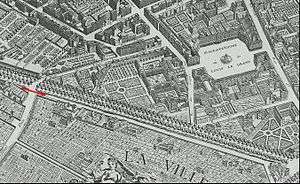Boulevards of Paris

Boulevards of Paris are boulevards which form an important part of the urban landscape of Paris. The boulevards were constructed in several phases by central government initiative as infrastructure improvements, but are very much associated with strolling and leisurely enjoyment in the minds of Parisians.
Parisian boulevards and avenues are usually tree-lined on one or both sides, which is rarely the case for smaller roads.
The grands boulevards


The Grands Boulevards are essentially 'the best' of the Parisian boulevards. They correspond to the Nouveau Cours built between 1668 and 1705 in place of the dismantled Louis XIII wall. The boulevards of Louis XIV were conceived by Pierre Bullet to link the Porte Saint-Antoine (situated where the Place de la Bastille now stands) to the Porte Saint-Honoré (situated where the Place de la Madeleine now stands).
Which ones exactly are classed among st the Grands Boulevards is somewhat unclear. Many Parisians would automatically include Boulevard Haussmann amongst them, as the large department stores (Printemps and Galeries Lafayette) draw promenaders in the "boulevardier spirit". However, strictly speaking, "les Grands Boulevards" would only include the Boulevard Beaumarchais, Filles-du-Calvaire, Temple, Saint-Martin, Saint-Denis, Bonne-Nouvelle, Poissonnière, Montmartre, Italiens, Capucines and the Madeleine boulevards.
Parisians made the boulevards into promenades which have remained popular through the ages and changes in the city. They were the setting for Maupassant's Bel Ami; Fred Astaire took to the boulevards in Funny Face (1957). The later opening of other trunk roads, namely Boulevard Richard-Lenoir, Boulevard Haussmann, and Avenue de la République, has somewhat reduced the visibility of the Grand Boulevards and the Louis XIII wall in the Paris topography.
"Boulevard du Crime"
The idea of the boulevard as a centre for leisure asserted itself during the 18th century, when numerous théâtres de la foire set up near the Porte Saint-Martin. The boulevard du Temple became affectionately known as "boulevard du Crime" during Bourbon Restoration, an allusion to the criminal acts portrayed there by stage actors. According to the Almanach des Spectacles, "Tautin was stabbed 16,302 times, Marti poisoned 11,000 times, Fresnoy set on fire 27,000 times in countless ways..., Mademoiselle Adèle Dupuis was seduced, kidnapped or drowned 75,000 times".[1]
Although the "boulevard du Crime" fell victim to Haussmann's transformation, the boulevardier spirit lives on in « théâtre de boulevard ».
Haussmannian boulevards
From 1784 to 1791, Ledoux built the Wall of the Farmers-General, with boulevards running along its exterior. This wall built to collect the octroi, a tax on goods entering the city which was hated by Parisians. It was demolished approximately between 1789 and 1860. Although it was almost completely razed by Haussman in 1860 as part of his transformation of Paris, some parts remain. The surviving boulevards were subject to urban planners' failed attempts in the 1950s to transform them into urban freeways.

Haussmann's renovation of Paris brought the boulevard to the heart of Paris, whereas they had hitherto been limited to uninhabited or sparsely inhabited zones. Le boulevard, whose initial function was to go around the capital, became structural urban thoroughfares.
The boulevards from Haussmann and before now define Paris, with uniform façades and overhanging balconies stretching along them. These are immediately recognisable, and are under the strict control of Paris' urban planners.
The boulevards des Maréchaux
The demolition of the Thiers wall during the 1920s allowed for the creation of a third ring of boulevards surrounding the city. These boulevards were named after the Marshals of the Empire, and, in consequence, they are called the Boulevards des Maréchaux (Boulevards of the Marshals). They run just inside the city limits.
In addition, the Boulevard périphérique, the beltway surrounding Paris, was built on the site of the ruins of the Thiers wall, a short distance 'outboard' from the boulevards of the marshals. However, it is more like a motorway than a boulevard. Paris Tramway Line 3 has been running along the Boulevards des Maréchaux since December 2006.
References
- Notes
- ↑ Cité par une presentation of the Théâtre Déjazet Archived 5 June 2008 at the Wayback Machine..
- 2. This page is mainly a translation of its French equivalent.
- Further reading
- Chadych, Danielle; Leborgne, Dominique (2002). Atlas de Paris. Parigramme. ISBN 2-84096-249-7.
External links
![]() Media related to Boulevards in Paris at Wikimedia Commons
Media related to Boulevards in Paris at Wikimedia Commons